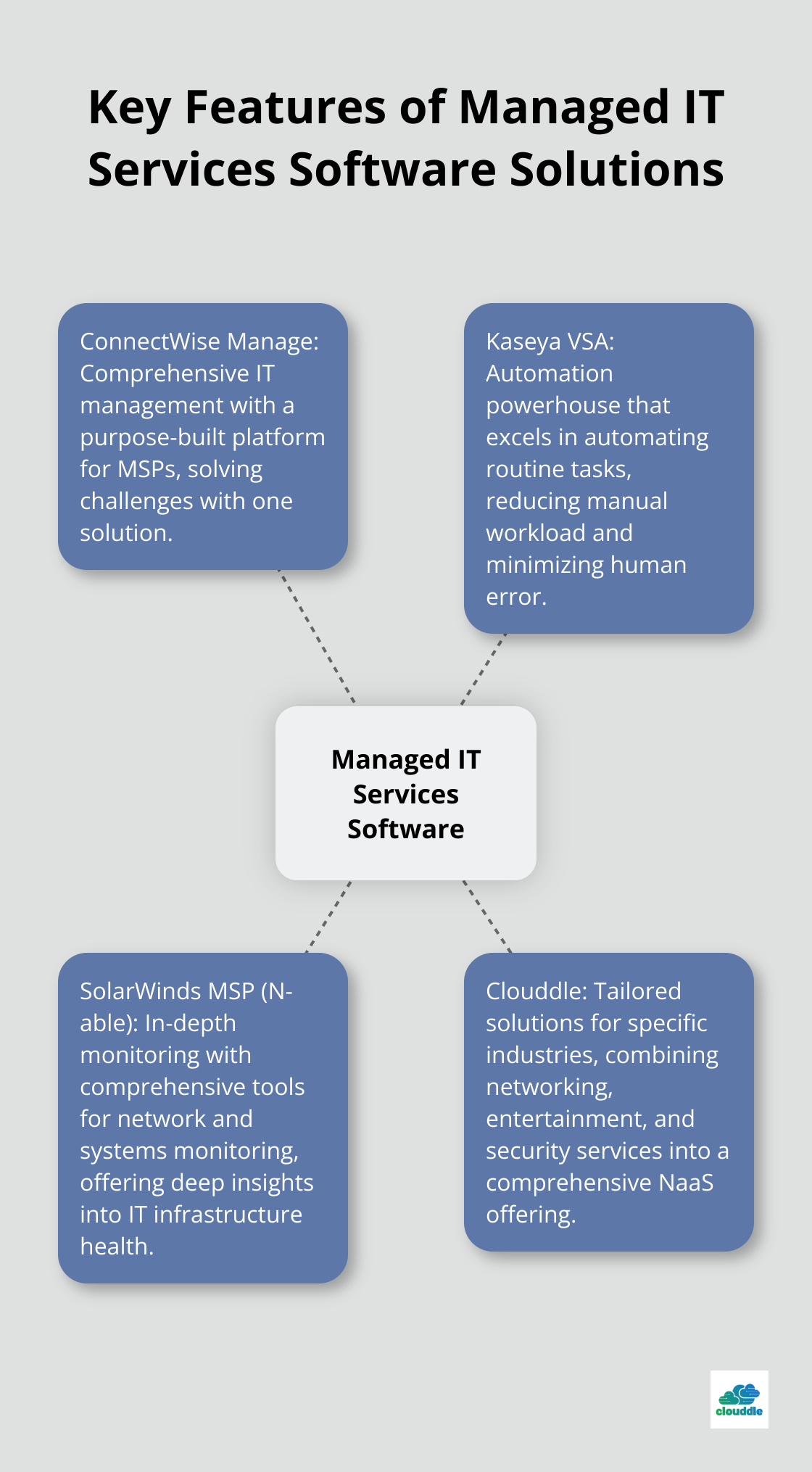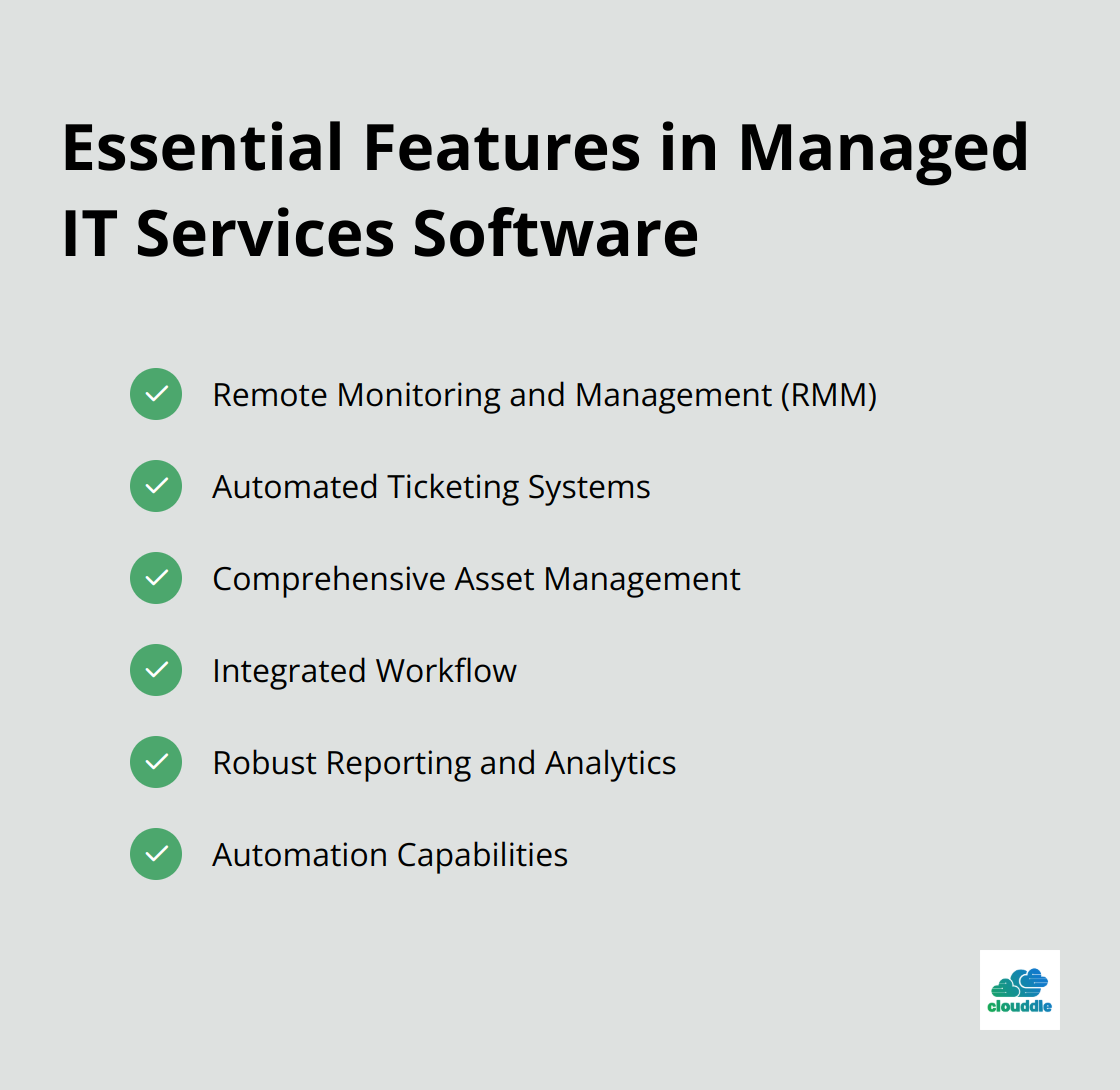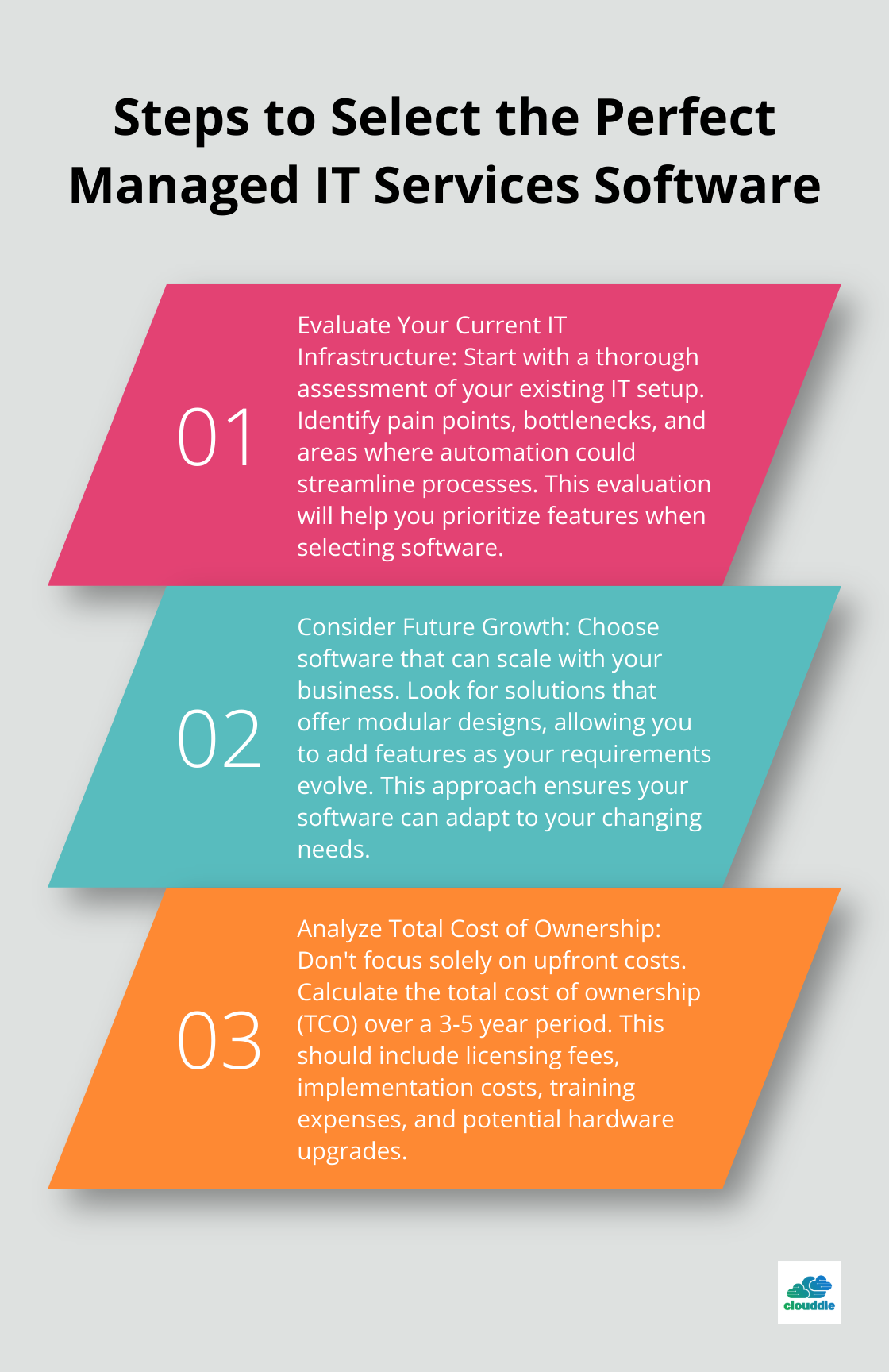Managed IT services software has become essential for businesses looking to streamline their IT operations. At Clouddle, we’ve seen firsthand how the right tools can transform a company’s efficiency and productivity.
In this post, we’ll explore the top software solutions that are revolutionizing the managed IT services landscape. We’ll also guide you through the key features to look for and provide tips on choosing the perfect fit for your business needs.
Leading Software Solutions in the Managed IT Services Market
The managed IT services landscape continues to evolve rapidly, with several software solutions emerging as market leaders. This section highlights some of the top platforms that have proven their worth in streamlining IT operations and boosting efficiency.
ConnectWise Manage: Comprehensive IT Management
ConnectWise Manage stands out as a powerhouse in the managed IT services sector. This platform is designed to solve any challenge with one platform, allowing businesses to operate more efficiently, reduce complexity, and improve EBITDA. Its purpose-built platform for MSPs offers a comprehensive solution for IT service management.
Kaseya VSA: Automation Powerhouse
Kaseya VSA excels in its automation capabilities. This solution allows IT professionals to automate routine tasks, which significantly reduces manual workload and minimizes the risk of human error. Automated workflows in Kaseya BMS/Vorex allow tickets to be automatically resolved by executing Kaseya VSA agent procedures, enhancing efficiency in ticket management.
SolarWinds MSP: In-Depth Monitoring
SolarWinds MSP (now known as N-able) offers a comprehensive suite of tools for network and systems monitoring. Its strength lies in providing deep insights into IT infrastructure health. The platform’s predictive analytics feature helps identify potential issues before they escalate, enabling proactive problem-solving.
Clouddle: Tailored Solutions for Specific Industries
While the aforementioned solutions offer robust features for general IT management, Clouddle stands out by providing tailored solutions for specific industries such as hospitality, multi-family dwelling, and senior living. Clouddle combines networking, entertainment, and security services into a comprehensive Network as a Service (NaaS) offering. This approach allows businesses to enjoy seamless operations and increased revenue without initial investment (a key differentiator in the market).

As we move forward, it’s important to consider the specific features that make these software solutions effective. The next section will explore the key components you should look for when selecting managed IT services software for your organization.
Essential Features in Managed IT Services Software
Remote Monitoring and Management (RMM)
RMM forms the foundation of effective managed IT services solutions. It empowers IT teams to monitor and manage systems remotely, which reduces on-site visits and improves response times. The molecular diagnostics market is expected to grow significantly, indicating the increasing importance of remote monitoring technologies across various industries.
Automated Ticketing Systems
An efficient ticketing system streamlines issue resolution and enhances customer satisfaction. The best software offers automated ticket creation, prioritization, and routing. Organizations that implement automated ticketing systems experience a reduction in mean time to resolution. This improvement translates to faster problem-solving and increased client satisfaction.
Comprehensive Asset Management
Effective asset management plays a vital role in maintaining an accurate inventory of hardware and software. This feature should track asset lifecycles, manage licenses, and provide insights into asset utilization. Organizations can reduce costs through improved IT asset management practices. This reduction leads to significant cost savings and better resource allocation.
Integrated Workflow
The true power of managed IT services software lies in the seamless integration of its features. When RMM detects an issue, it should automatically create a ticket and assign it to the appropriate technician. This integration ensures swift problem resolution and maintains high service levels (a key factor in client retention).
Robust Reporting and Analytics
Software should offer comprehensive reporting and analytics capabilities. These tools provide valuable insights into system performance, help identify trends, and support data-driven decision-making. Businesses recognize that analytics helps them make better decisions. This data-driven approach leads to more informed strategies and improved operational efficiency.
Automation Capabilities
Automation stands out as a critical feature in managed IT services software. From patch management to routine maintenance tasks, automation significantly reduces manual workload and minimizes human error. A technical call center reduced its costs by more than 40 percent while increasing quality of service through automation. This reduction not only improves efficiency but also allows IT professionals to focus on more strategic tasks.

As we explore these essential features, it becomes clear that choosing the right managed IT services software requires careful consideration of your specific business needs. The next section will guide you through the process of selecting the perfect solution for your organization.
How to Select the Perfect Managed IT Services Software
Evaluate Your Current IT Infrastructure
Start with a thorough assessment of your existing IT setup. Identify pain points, bottlenecks, and areas where automation could streamline processes. This evaluation will help you prioritize features when selecting software. If your team spends excessive time on manual ticket routing, prioritize solutions with advanced automated ticketing systems.
Consider Future Growth
It’s important to choose software that can scale with your business. Look for solutions that offer modular designs, allowing you to add features as your requirements evolve. Grow your customer base, expand business reach, drive revenue and scale quickly with essential SaaS growth strategies.
Analyze Total Cost of Ownership
Don’t focus solely on upfront costs. Calculate the total cost of ownership (TCO) over a 3-5 year period. This should include licensing fees, implementation costs, training expenses, and potential hardware upgrades.
Prioritize User Experience
The most feature-rich software becomes useless if your team can’t navigate it efficiently. Look for intuitive interfaces and customizable dashboards. Request demos or trial periods to allow your team to test the software.
Assess Integration Capabilities
Your chosen software should seamlessly integrate with your existing tools and workflows. Check for pre-built integrations with popular business applications and APIs for custom integrations. Business process automation tools like Claromentis, Automation Anywhere, UiPath, and Microsoft Power Automate can help streamline your operations.

Final Thoughts
Selecting the right managed IT services software can transform business operations. Each platform offers unique strengths to address diverse needs, from comprehensive IT management to powerful automation capabilities. The appropriate tool will streamline operations, enhance productivity, and provide valuable insights for data-driven decision-making.
Artificial intelligence and machine learning will play increasingly significant roles in managed IT services software. These technologies will offer more sophisticated predictive analytics and automated problem-solving capabilities. We also expect to see greater emphasis on cybersecurity features and compliance management tools as businesses face evolving digital threats and regulatory landscapes.
At Clouddle, we understand the critical role of managed IT services software in modern business operations. Our Network as a Service (NaaS) solution combines networking, entertainment, and security services, providing a comprehensive approach to IT management without the need for initial investment. This allows businesses to focus on growth and efficiency while we handle the complexities of IT infrastructure.


